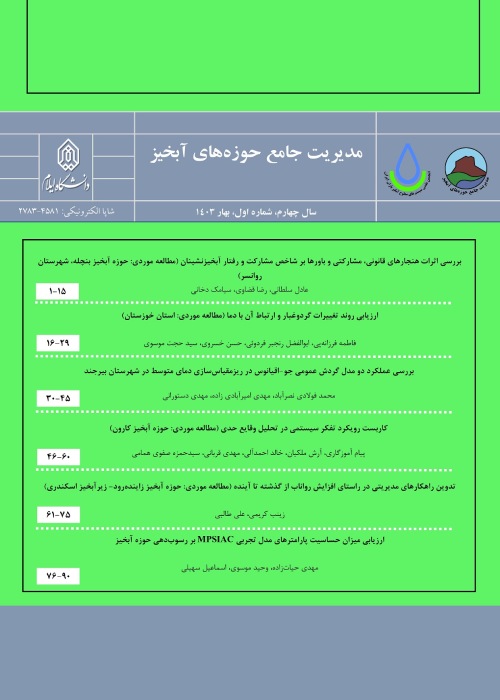Performance Evaluation and Exit Strategy in Chehelchai Watershed Management
The world faces a multitude of important problems and challenges, including rapid population growth, economic crises, improper natural resource management, climate change, increasing poverty, and hunger, which have led to an increase in the exploitation of natural resources. It is important to remember that any decision made in one part of a watershed can have consequences for other parts, ultimately affecting the watershed's overall performance. To determine the stability of a watershed, it is necessary to consider all aspects and factors involved, with all indicators in line with one another, and ensure that they overlap across all sections and layers. Over the past two decades, significant progress has been made in improving planning, implementation approaches, and designing appropriate policy frameworks for sustainable watershed health. While many watershed management projects have achieved positive outcomes, they often revert to their previous state without outgoing proposals for further watershed improvement.
This study was conducted with the aim of evaluating the performance and exit strategies of Chehelchai watershed projects. The method used in this study is provided by Zeleke (2014). According to this method, by combining periodical reports in the watershed area, the exit strategy framework, the quantity and quality of the achievements and the development stages of the watershed can be formulated. To score each of these indicators, group analysis is used in this method. The participants of this group discussion were village leaders and trustees, watershed management team, local people and experts working in the watershed. The indicators examined in this study included economic, social, ecological response, the commitment of the leaders of the two prominent villages of Duzein and Qalaqafeh, and the commitment of the communities. Each of these indicators has a specific number of sub-indices, which were used to score each index.
According to the results of the investigation of 6 indicators, the amount of stability of the study area was obtained and the strengths and weaknesses of the watershed were evaluated. The results of this research showed that this method has a good potential to evaluate the stability of the watershed and identify the exit strategy in watershed management due to the involvement of various indicators. This method has smoothed out problems such as lack of access to appropriate data, time-consuming, high cost, and lack of quantification of some parameters. The present study can be used as a model for evaluating other watershed areas in other regions of the country. The results showed improvement in both X and Y axis indicators for the Chehelchai watershed. The ecological index was favorable compared to the social and economic indices. To improve stability, more attention should be paid to the economic and social aspects. Strengthening the social index requires greater involvement of women in planning and implementation, addressing their needs and interests. Recruiting educated, successful, and motivated women for development groups and cooperatives, providing facilities for local businesses, and home business training can improve the social and economic indices. The commitment index of Dozein village leaders can be improved through increased follow-up and reporting requirements. For Qalaqafeh leaders, implementing regulations, monitoring, reporting, and community coordination can help. For communities, motivational activities, establishing and respecting regulations, supporting youth initiatives, and participating in associations are important. Using trusted community members to explain watershed goals and involving leaders through reports and site visits builds confidence between stakeholders, which is critical for sustainability. Any watershed effort lacking economic and social acceptance will not last.
To achieve acceptable sustainability, it is essential to evaluate the watershed based on a range of indicators, including ecosystem and socio-economic factors, as well as the commitment levels of leaders and communities. This evaluation process is critical to ensuring the protection of the watershed's natural resources and to providing a favorable living environment for both local residents and others who depend on the watershed. People rely on these resources for their livelihoods. However, one crucial aspect that has received little attention in the examination of watershed sustainability is the development of exit strategies from the basin. This oversight has resulted in many watershed management projects achieving positive results but failing to provide output proposals for further improving the watersheds. Thus, it is crucial to approach this category with greater sensitivity in both studies and implementation.
- حق عضویت دریافتی صرف حمایت از نشریات عضو و نگهداری، تکمیل و توسعه مگیران میشود.
- پرداخت حق اشتراک و دانلود مقالات اجازه بازنشر آن در سایر رسانههای چاپی و دیجیتال را به کاربر نمیدهد.


